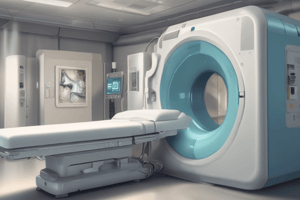Podcast
Questions and Answers
Which factor in CT radiation source requirement is a function of radiation beam energy, the atomic number and density of the absorber, and the thickness of the object?
Which factor in CT radiation source requirement is a function of radiation beam energy, the atomic number and density of the absorber, and the thickness of the object?
- Quantity of radiation required for transmission
- Material composition of the anode disk
- Radiation attenuation (correct)
- Rotation speed of the X-ray tube
Why have rotating anode X-ray tubes become common in CT scanners?
Why have rotating anode X-ray tubes become common in CT scanners?
- To decrease output due to high demand
- To minimize rotation speed
- To reduce heat generation
- To facilitate spatial resolution requirements (correct)
What material(s) are typically used to make the anode disk in rotating anode tubes for CT?
What material(s) are typically used to make the anode disk in rotating anode tubes for CT?
- Carbon fiber composite
- Titanium and vanadium alloy
- Aluminum and copper alloy
- Rhenium, tungsten, and molybdenum alloy (correct)
What advantage does a rotating anode tube with a small target angle offer in CT scanners?
What advantage does a rotating anode tube with a small target angle offer in CT scanners?
Which technical advance in X-ray tube design was specifically made to manage heat-related issues in continuous rotation CT scanners?
Which technical advance in X-ray tube design was specifically made to manage heat-related issues in continuous rotation CT scanners?
Why must X-ray tubes in spiral/helical CT scanners be able to sustain higher power levels compared to conventional scanners?
Why must X-ray tubes in spiral/helical CT scanners be able to sustain higher power levels compared to conventional scanners?
Flashcards are hidden until you start studying
Study Notes
X-Ray Tubes in CT Scanners
- Radiation source requirements in CT depend on radiation attenuation and quantity of radiation required for transmission
- X-ray tubes satisfy these requirements
- Rotating anode X-ray tubes are commonly used in CT due to the demand for increased output
Characteristics of Rotating Anode Tubes
- Large-diameter anode disks facilitate spatial resolution requirements of the scanner
- Disks are typically made of rhenium, tungsten, and molybdenum (RTM) alloy and other materials
- Small target angle (usually 12 degrees) and rotation speed of 3600-10,000 revolutions per minute (rpm)
Demands of Spiral/Helical CT on X-Ray Tubes
- Continuous rotation scanners require tubes to sustain higher power levels for longer periods
- Technical advances in component design necessary to achieve higher power levels and manage heat generation, storage, and dissipation
- Redesigned components include tube envelope, cathode assembly, anode assembly, and target design
Studying That Suits You
Use AI to generate personalized quizzes and flashcards to suit your learning preferences.




